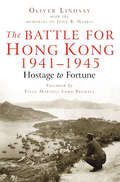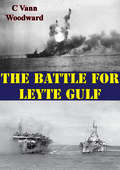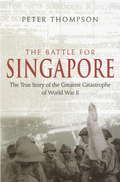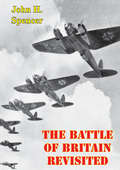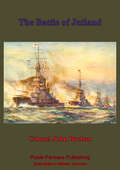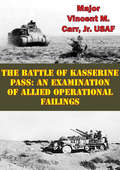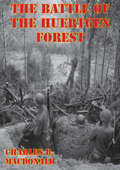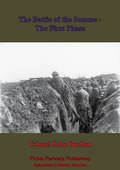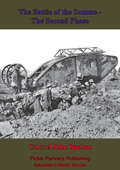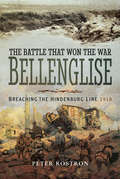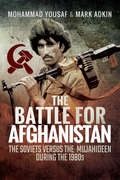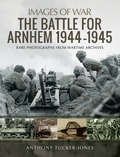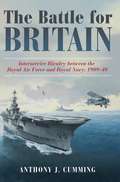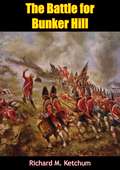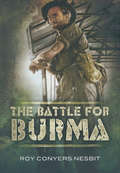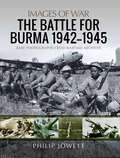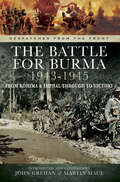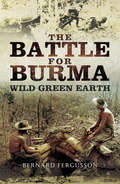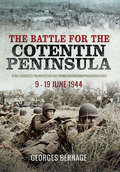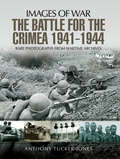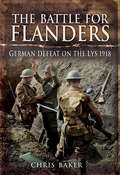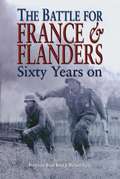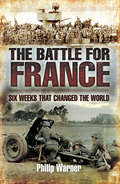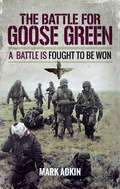- Table View
- List View
The Battle For Hong Kong 1941-1945: Hostage to Fortune
by Oliver LindsayIn this remarkable study of the Far Eastern War, Oliver Lindsay and John R Harris have provided the most thorough and searching enquiry into the debacle which led to over 12,000 British, Canadian, Indian and Chinese defenders surrendering Hong Kong on Christmas Day 1941. The authors have made use of a mass of unpublished material - part of it drawn from the original war diaries which have never before been in the public domain. Although it is over 60 years since Hong Kong was liberated from the Japanese, numerous important questions regarding the war in the East and occupation of the Colony from 1941 to 1945 have not been explored until now. To what extent, for example, were Churchill and the successive Chiefs of the Imperial General Staff responsible for abandoning this outpost, which could not be reinforced when attacked or defended adequately? Is it true that fine leadership prolonged the fighting, inflicting serious casualties on the highly experienced Japanese when they struck in 1941? How useful was Britain's spying organization in China, which led to catastrophic repercussions for the POWs and Internees? What form did the Japanese atrocities take upon the helpless captives? This detailed and authoritative account of the campaign will provide a particularly compelling read for those interested in the Second World War or the history of the Far East.
The Battle For Leyte Gulf [Illustrated Edition]
by C. Vann WoodwardIncludes 6 charts and 20 photosPulitzer prize winning author C. Vann Woodward recounts the story of the largest naval battle of all time."The Battle for Leyte Gulf was the greatest naval battle of the Second World War and the largest engagement ever fought on the high seas. It was composed of four separate yet closely interrelated actions, each of which involved forces comparable in size with those engaged in any previous battle of the Pacific War. The four battles, two of them fought simultaneously, were joined in three different bodies of water separated by as much as 500 miles. Yet all four were fought between dawn of one day and dusk of the next, and all were waged in the repulse of a single, huge Japanese operation."They were guided by a master plan drawn up in Tokyo two months before our landing and known by the code name Sho Plan. It was a bold and complicated plan calling for reckless sacrifice and the use of cleverly conceived diversion. As an afterthought the suicidal Kamikaze campaign was inaugurated in connection with the plan. Altogether the operation was the most desperate attempted by any naval power during the war-and there were moments, several of them in fact, when it seemed to be approaching dangerously near to success."Unlike the majority of Pacific naval battles that preceded it, the Battle of Leyte Gulf was not limited to an exchange of air strikes between widely separated carrier forces, although it involved action of that kind. It also included surface and subsurface action between virtually all types of fighting craft from motor torpedo boats to battleships, at ranges varying from point-blank to fifteen miles, with weapons ranging from machine guns to great rifles of 18-inch bore, fired "in anger" by the Japanese for the first time in this battle."
The Battle For Singapore: The true story of the greatest catastrophe of World War II
by Peter ThompsonThe Fall of Singapore on 15 February 1942 is a military disaster of enduring fascination. For the 60th anniversary of the liberation of the island, Peter Thompson tells the explosive story of the Malayan campaign, the siege of Singapore, the ignominious surrender to a much smaller Japanese force, and the Japanese occupation through the eyes of those who were there - the soldiers of all nationalities and members of Singapore's beleaguered population. An enthralling and perceptive account, which never loses sight of the human cost of the tragedy - Yorkshire Evening Post. An insightful and dramatic analysis - The Good Book Guide
The Battle Of Britain Revisited
by Group Captain John H. SpencerThe North Atlantic Treaty Organization (NATO) was formed as, and remains, a defensive alliance. It is axiomatic therefore, that in the event of a war in Europe, NATO forces would be initially on the defensive. It is also likely that the Warsaw Pact (WP) forces would use all the considerable means at their disposal to achieve their war aims, including air power, and in the past 50 years or so, air power has had a considerable, some would even say a decisive, role to play in the conduct of war. From the foregoing, it can be seen that NATO air defences would be a vital pillar in the overall defence of Western Europe and that should they fail, or be overcome, then the achievement of NATO war aims would be made very much more difficult. In this context, it would seem worthwhile to examine one of the very few air defence campaigns of the past that succeeded and to see what lessons can be learnt from it that have relevance for today.Arguably, the most notable example of a successful air defence campaign was the Battle of Britain, which took place in the summer and autumn of 1940. Many books articles, and reminiscences have been published about the struggle and this study does not intend to give a detailed blow-by-blow account but rather to analyse the campaign and highlight those aspects which seem of particular importance to the outcome of the battle. It may be that some of these illuminate the eternal verities of warfare and are therefore as important today as they ever were.
The Battle Of Jutland
by Colonel John BuchanThe one and only major naval engagement of the First World War stands alone in the history of Warfare afloat. It is a curious battle to study as a German tactical victory, but rather a British strategic victory. Colonel Buchan wrote his volume study of the battle from an enviable position as a high ranking intelligence officer, having access to much of the detail from the allied side. He divided the action into four distinct phases as the battle ships and cruisers manoeuvred for position and the shells rained among them. One of the finest British authors of the age, he also wrote copious numbers of books on the First World War, of particular note the 24 volume "Nelson's" history.
The Battle Of Kasserine Pass: An Examination Of Allied Operational Failings
by Major Vincent M. Carr Jr. USAFThe Battle of Kasserine Pass proved to be a shock both to American military forces in the field and to the American public at home. The defeat of the Allied forces in the battle put doubt into the minds of many--all of whom assumed the righteous democracies of the western Allies could not be defeated in the field by the armies of Fascism. The defeat suffered by the Allies had nothing to do with right versus wrong, however, but was very much a product of a number of operational shortcomings on the part of the Allies. Poor logistics, failures on the part of American leadership, lack of unity of effort on the part of the Allies, the lack of combat experience, and inferior equipment all combined to contribute to the failure at Kasserine. Despite the setback at Kasserine Pass, the Americans proved quick learners, and applied the lessons of the North African experience to the remainder of their campaign in the European theater.
The Battle Of The Huertgen Forest [Illustrated Edition]
by Charles Brown MacdonaldIncludes the Siegfried Line Campaign Map Pack - 19 maps and 81 photos“"A testament of the courage and endurance of our fighting men."-New York Times“In September 1944, three months after the invasion of Normandy, the Allied armies prepared to push the German forces back into their homeland. Just south of the city of Aachen, elements of the U.S. First Army began an advance through the imposing Huertgen Forest. Instead of retreating, as the Allied command anticipated, the German troops prepared an elaborate defense of Huertgen, resulting in a struggle where tanks, infantry, and artillery dueled at close range. The battle for the forest ended abruptly in December, when a sudden German offensive through the Ardennes to the south forced the Allied armies to fall back, regroup, and start their attack again, this time culminating in the collapse of the Nazi regime in May 1945.“In The Battle of the Huertgen Forest, Charles B. MacDonald assesses this major American operation, discussing the opposing forces on the eve of the battle and offering a clearly written and well-documented history of the battle and the bitter consequences of the American move into the forest. Drawing on his own combat experience, MacDonald portrays both the American and the German troops with empathy and convincingly demonstrates the flaws in the American strategy. The book provides an insight into command decisions at both local and staff levels and the lessons that can be drawn from one of the bloodiest battles of World War II.“Charles B. MacDonald was deputy chief historian of the Army Center of Military History. He commanded a rifle platoon in World War II, earning the Silver Star, a Purple Heart, and five battle stars. He recorded his wartime experiences in Company Commander, regarded as one of the finest World War II combat narratives.”-Print Ed.
The Battle Of The Somme - The First Phase. [Illustrated Edition]
by Colonel John BuchanMore than any other battle of the First World War, the battle of the Somme remains as the abiding memory of the appalling conditions, suffering and death of British manhood in the public consciousness. As the guns stopped their bombardment on the 1st of July, the waves of Allied troops walked toward the often still intact German lines. More than a million men in total would be killed, wounded or captured on both sides before the fighting subsided in November.Colonel Buchan wrote his volume study of the battle from an enviable position as a high ranking intelligence officer, having access to much of the detail from the allied side of the offensive. One of the finest British authors of the age, he also wrote copious numbers of books on the First World War, of particular note the 24 volume 'Nelson's" history.Author -- Colonel Buchan, John, (Later Lord Tweedsmuir) 1875-1940.Text taken, whole and complete, from the edition published in London, T. Nelson and sons, ltd. 1916.Original Page Count - 108 pages.Illustrations -- numerous illustrations and plates
The Battle Of The Somme –The Second Phase. [Illustrated Edition]
by Colonel John BuchanMore than any other battle of the First World War, the battle of the Somme remains as the abiding memory of the appalling conditions, suffering and death of British manhood in the public consciousness. As the guns stopped their bombardment on the 1st of July, the waves of Allied troops walked toward the often still intact German lines. More than a million men in total would be killed, wounded or captured on both sides before the fighting subsided in November.Colonel Buchan wrote his volume study of the battle from an enviable position as a high ranking intelligence officer, having access to much of the detail from the allied side of the offensive. One of the finest British authors of the age, he also wrote copious numbers of books on the First World War, of particular note the 24 volume 'Nelson's" history.Author -- Colonel Buchan, John, (Later Lord Tweedsmuir) 1875-1940.Text taken, whole and complete, from the edition published in London, T. Nelson and sons, ltd. 1916.Original Page Count - 108 pages.Illustrations -- numerous illustrations and plates.
The Battle That Won the War: Breaching the Hindenburg Line, 1918
by Peter RostronIt is no exaggeration to claim that 46th North Midland Divisions action on 29 September 1918 was the hammer blow that shattered the will of the German High Command.Painting the strategic picture from early 1918 and the dark weeks following the Germans March offensive, the Author lays the ground for the Allied counter-strike. Ahead of them was the mighty Hindenburg Line, the Kaisers formidable defensive obstacle given added strength by the St Quentin Canal.Undaunted the Allies attacked using American, Australian and British formations. Led by Major General Boyd, 46 Division stormed the Canal and, thanks to a combination of sound planning and determined courageous fighting, seized their Hindenburg Line objective by the end of the day.The psychological damage to the German will, already weakened by the failure of the Spring offensive, is demonstrate by Ludendorffs collapse and opening of negotiations that led five weeks later to the Armistice.
The Battle for Afghanistan: The Soviets Versus the Majahideen During the 1980s
by Mark Adkin Mohammad YousafThis is the story of the defeat of Soviet Russia's forces in Afghanistan by a guerrilla force known as the Mujahideen, heavily backed by Pakistan and the USA. The Mujahideen paved the way for the Taliban regime, to exist having all but defeated the Russian Army in the late 80's.The author, Brigadier Mohammad Yousaf, was head of the Afghan Bureau of Pakistan's Inter-Service Intelligence and as such was effectively the Mujahideen's commander-in-chief. He controlled the flow of thousands of tons of arms across Pakistan and into its occupied neighbor, arms that were bought with CIA and Saudi Arabian funds from the USA. One of the Mujahideen's close allies was none other than Osama Bin Laden.This compelling book was put together with great skill the by military historian, Mark Adkin in conjunction with Brigadier Mohammad Yousaf and is essential reading for anyone interested in the truth behind the Afghanistan War which led to the conditions that exist there today.A hardback edition of this book was published by Casemate in 2001 under the title Afghanistan: The Bear Trap.
The Battle for Arnhem 1944–1945: Rare Photographs From Wartime Archives (Images of War)
by Anthony Tucker-JonesA photographic history of WWII&’s Operation Market Garden and the Allies&’ quest for the famed &“Bridge Too Far.&” Operation Market Garden, September 1944, the Netherlands. Three parachute drops and one armored charge. The prize was the last bridge at Arnhem over the Neder Rijn. Taken intact, it would provide the Allies with a backdoor into Germany—the famous &“Bridge Too Far.&” This was one of the most audacious and imaginative operations of the war, and it failed. Anthony Tucker-Jones&’s photographic history, with a sequence of almost 200 archive photographs accompanied by a detailed narrative, describes the landing of British and American parachutists and glider troops. At the same time, British tanks spearheaded a sixty-mile dash along &“Hell&’s Highway&” to link up with the lightly armed and heavily outnumbered airborne forces. Most books about the resulting battle concentrate on the struggle at Arnhem and the heroism of the British 1st Airborne Division. This book puts that episode in its wider context. In particular it focuses on the efforts of the US 101st and 82nd airborne divisions to hold off counterattacks by German battlegroups during the tanks&’ advance. The photographs give a dramatic insight into all sides of a remarkable but ill-fated operation which has fascinated historians and been the subject of controversy ever since. They also portray, as only photographs can, the men who were involved and the places and conditions in which the fighting took place.
The Battle for Britain
by Anthony J. CummingThe book is a short review of British air and naval power from 1909 -1940 and represents an attack upon "independent” airpower. When Bleriot became the first man to fly the English Channel in a heavier-than-air flying machine in 1909, it seemed to mark the beginning of a fundamental decline in British attitudes towards maritime defense. Exploiting prevalent invasion paranoia, press baron, Lord Northcliffe invited distinguished writers such as William Le Queue and H G Wells to write articles on the theme "We are no longer an Island”. Bleriot’s exploit encouraged the politicians to reassess how Britain would be defended in the future. An important government committee heard evidence that led directly to the forming of the Royal Flying Corps - an organization that initially included army and naval wings. Superficially, the Royal Navy was moving from strength to strength as it expanded in the naval arms race with Germany. The service remained in high public esteem but a section of the ruling Liberal party wanted money diverted for welfare - a new and powerful competitor for funds. The Two-Power Standard was quietly dropped in 1909 and the astronomical costs of battleship building forced the Navy to look for cheaper substitutes such as submarines and aircraft. A forceful critic of naval expenditure, Winston S. Churchill fostered the early development of airpower when he became First Lord in 1911 and continued to do so when out of office. The German air raids of 1917 panicked the wartime government into making an ill-considered merger of naval and army air arms that supported imaginative but untried theories of airpower. In 1938, a later government submitted to the national psychosis of bombing by allowing the Royal Air Force to be the only service to rearm without regard to the nation’s ability to afford it. In 1940, the contribution of the Royal Navy was minimized as Churchill praised the RAF for saving the nation from invasion in the Battle of Britain. As a result the RAF’s story has achieved an iconic status that is part of British national identity. Consequently, more important operations including the Dunkirk evacuation; Battle of the Atlantic; Battle of Mers El Kebir and the naval operations against the Italian fleet have been underrated and misunderstood. This ultimate justification of independent airpower continues to undermine understandings of maritime defense and may have skewed US and UK defense policies in the wrong direction for decades.
The Battle for Bunker Hill
by Richard M. KetchumBoston, 1775: A town occupied by General Thomas Gage's redcoats and groaning with Tory refugees from the Massachusetts countryside. Besieged for two months by a rabble in arms, the British decided to break out of town. American spies discovered their plans, and on the night of June 16, 1775, a thousand rebels marched out onto Charlestown peninsula and began digging a redoubt (not on Bunker Hill, which they had been ordered to fortify, but on Breeds Hill, well within cannon shot of the British batteries and ships). At daybreak, HMS Lively began firing. It was the opening round of a battle that saw unbelievable heroism and tragic blunders on both sides (a battle that marked a point of no return for England and her colonies), the beginning of all-out war.
The Battle for Bunker Hill: The Battle For Bunker Hill
by Richard M. KetchumBoston, 1775: A town occupied by General Thomas Gage’s redcoats and groaning with Tory refugees from the Massachusetts countryside. Besieged for two months by a rabble in arms, the British decided to break out of town. American spies discovered their plans, and on the night of June 16, 1775, a thousand rebels marched out onto Charlestown peninsula and began digging a redoubt (not on Bunker Hill, which they had been ordered to fortify, but on Breeds Hill, well within cannon shot of the British batteries and ships). At daybreak, HMS Lively began firing. It was the opening round of a battle that saw unbelievable heroism and tragic blunders on both sides (a battle that marked a point of no return for England and her colonies), the beginning of all-out war.With impeccable scholarship, Richard M. Ketchum’s 1962 book describes the historic setting and importance of the battle, analysing the character and motives, as well as the many blunders, of responsible leaders on both sides. He gives a detailed and fascinating depiction of the battle, recapturing in graphic style each witness account.
The Battle for Burma
by Roy Conyers NesbitThe struggle of British, Commonwealth and American-Chinese troops against the Japanese in Burma was one of the decisive campaigns of the Second World War. British India was threatened by the Japanese advance, the fate of the British Empire in the East hung in the balance. The tropical climate dense malarial jungle infested with vermin and swept by monsoon rains made the fighting, for both sides, a remarkable feat of arms. Yet the war in Burma rarely receives the attention it deserves. Roy C. Nesbit, in this highly illustrated account, traces the entire course of the campaign. In vivid detail he describes the British retreat and humiliation at the hands of the Japanese invaders in 1942. The Japanese were fanatical and trained in jungle warfare, well-equipped and backed with an overwhelming air power. The Allied response was to build up their forces on a massive scale eventually over 1,300,000 personnel were involved and to train them to fight in the jungle conditions. Their counter-offensive, launched in 1944, culminated in the battles at Imphal and Kohima which turned the course of the conflict, and the reconquest of Burma was achieved just before the atom bomb was dropped.
The Battle for Burma, 1942–1945: Rare Photographs From Wartime Archives (Images of War)
by Philip JowettThe battle for Burma during the Second World War was of vital importance to the Allies and the Japanese. The Allies fought to protect British India and force the Japanese out of Burma; the Japanese fought to defend the north-west flank of their newly conquered empire and aimed to strike at India where anti-British feeling was growing stronger. Yet the massive military efforts mounted by both sides during four years of war are often overshadowed by the campaigns in Europe, North Africa, the Pacific and China. Philip Jowett, using over 200 wartime photographs, many of them not published before, retells the story of the war in Burma in vivid detail, illustrating each phase of the fighting and showing all the forces involved – British, American, Chinese, Indian, Burmese as well as Japanese. His book is a fascinating introduction to one of the most extreme, but least reported, struggles of the entire war. The narrative and the striking photographs carry the reader through each of the major phases of the conflict, from the humiliation of the initial British defeat in 1942 and retreat into India and their faltering attempts to recover the initiative from 1943, to the famous Chindit raids behind Japanese lines, the Japanese offensive of 1944 and their disastrous retreat and ultimate defeat.
The Battle for Burma, 1943–1945: From Kohima & Imphal Through to Victory (Despatches from the Front)
by Martin Mace John GrehanDespatches in this volume include that on operations in Burma and North-East India between November 1943 and June 1944, by General Sir George J. Giffard; the despatch on operations in Assam and Burma between June 1944 June and November 1944, by General Sir George J. Giffard, Commander-in-Chief; the despatch on Naval operations in the Ramree Island area (Burma) in January and February 1945 by Vice-Admiral Sir Arthur J. Power, Commander-in-Chief, East Indies Station; and the despatch on operations in Burma between November 1944 and August 1945 by Lieutenant-General Sir Oliver Leese.This unique collection of original documents will prove to be an invaluable resource for historians, students and all those interested in what was one of the most significant periods in British military history.
The Battle for Burma: Wild Green Earth
by Bernard FergussonBernard Fergusson was one of Orde Wingate's Column Commanders in the heroic but battered Chindit expedition behind Japanese lines in Burma in 1943. By 1944 Wingate had persuaded Churchill and Roosevelt that a bigger force, on the same unorthodox lines, could make a strategic difference. Aged 32, Fergusson returned to Burma as part of this, as a Brigadier, leading the only Brigade in the new force which entered Burma on foot. It was one of four Brigades which established well-defended strongholds within Japanese-occupied Burma. Fergusson also reflects candidly, and often humorously, on different aspects of the campaign. These include the ingenuity and sheer courage of the US Army Air Force pilots who flew in supplies and evacuated wounded. One glider pilot whom Fergusson saw making a particularly bad landing turned out to be Jackie Coogan, child star of Chaplin's The Kid, and later known as Uncle Fenster of the Addams Family. In apparently light hearted, but often profound sections, he analyses the management of a large and diverse force, up against physical extremes far from normal amenities and command structures; the importance of maintaining morale and of medical management; and, not least, an immediate portrait of Wingate himself, whose death at a crucial stage of the campaign and the conflicting or at least confusing orders he left behind directly affected Fergusson's men and the fate of the campaign.The Wild Green Earth follows the author's account of the 1943 campaign, Beyond the Chindwin. Both were written with the events, and reactions even the smells fresh in the author's mind, and vividly but sensitively conveyed. The excitement of the narrative remains today. And the reflections are timeless, fascinating for those with an interest in leadership and motivation as much as for readers of military history.
The Battle for Cotentin Peninsula: 9–19 June 1944
by Georges BernageIn June 1944, the Americans left the Sainte-Mre-Eglise and Utah Beach bridgehead and crossed the Merderet river to the Chausse de la Fiere, taking Picauville on 10 June. Their advance was slowed following the failure of the 90th Infantry Division, but they were able to take Pont-l'Abbe on 12 June and Saint-Sauveur-le-Vicomte 16 June. Two days later they cut the Cotentin peninsula at Barneville, before heading north towards Cherbourg.As well as authentic eyewitness testimony, the book also acts as a field guide, including maps and both contemporary and modern photographs.
The Battle for Crimea, 1941–1944 (Images of War)
by Anthony Tucker-JonesThe selection of over 150 rare wartime photographs in this volume in Pen & Swords Images of War series offers a graphic visual record of the dramatic and bloody battles fought for the Crimea during the Second World War. They show every grim aspect of the fighting and reflect in many ways the ruthless character of the struggle across the entire Eastern Front. The German-led Axis forces took eight months to conquer the Crimea in 1941-2 the Soviet defenders of the fortified city-port of Sevastopol held out against repeated assaults for 250 days. In 1944, after the course of the war had turned against the Wehrmacht and their allies, the city was liberated by the Red Army, but only after over 120,000 Axis troops had been evacuated across the Black Sea. Naval operations involving the Soviet Black Sea Fleet and the Romanian Royal Navy are covered in the book, as is the battle in the air between the Luftwaffe and the Red Air Force. But perhaps the most memorable photographs give an insight into the ordinary soldiers experience of the fighting and show the enormous material damage the conflict left behind.
The Battle for Flanders: German Defeat on the Lys 1918
by Chris BakerThe Battle of the Lys, fought in April 1918, was critical for the Allies and for Germany. The outcome of the Great War hung in the balance. After the successful German offensive on the Somme, their breakthrough on the Lys threatened Ypres and the British hold on Flanders and brought them close to victory on the Western Front. The Allied line was broken it was only saved by improvisation and great gallantry—and the German onslaught tested Allied cooperation under the newly appointed Generalissimo Ferdinand Foch to the limit. Yet, as Chris Baker shows in this compelling account, the declining force of the German attack revealed deficiencies in material, organization and morale that led to their ultimate defeat.
The Battle for France & Flanders: Sixty Years On (Military History Ser.)
by Michael Taylor Brian BondThe Fall of France in 1940 has been well chronicled but numerous misconceptions remain.This fascinating and thought-provoking collection of essays on wide-ranging issues covering the politics and fighting on land, sea and in the air will be greatly welcomed by academics and military history enthusiasts.Topics covered include the preparations of the BEF, the failure of allied counter attacks, the air war, the Royal Navys's role in the campaign, the influence of the Battle on British military doctrine and the repercussions from the British, French and German angles.
The Battle for France: Six Weeks That Changed The World
by Philip Warner“Provides a fresh and invaluable explanation of the military and political events of that extraordinary campaign.” —Scale Military Modeller InternationalAfter the long winter of the Phoney War, the invasion of the Low Countries and France by Hitler’s rampaging armies threw the world into crisis. Chamberlain’s government fell, Churchill became Prime Minister. France was humiliated, the British Expeditionary Force was only saved by the miracle of Dunkirk but many men and huge amounts of equipment were lost to the Blitzkrieg. England trembled but the invasion never came.Philip Warner graphically recounts the momentous events of that terrible period thanks to his painstaking research and skillful writing. He demonstrates how the under trained and ill-equipped British forces gallantly but futilely resisted the German land and air onslaught. He emphasizes the understated contribution of the French. This book provides a fresh and invaluable explanation of the military and political events of that extraordinary campaign, which continued on after Dunkirk.
The Battle for Goose Green: A Battle is Fought to be Won (Cassell Military Paperbacks Series)
by Mark Adkin&“Probably the best and most detailed description of a key battle in the 1982 Falklands War . . . an excellent and fast paced narrative.&” —Michael McCarthy, historical battlefield guide This book tells the story of the battle for Goose Green—the first crucial clash of the Falklands War—through the eyes of the commanders, both British and Argentine, from brigadier to corporal. It follows in detail, with the aid of maps, the fourteen hours of vicious infantry as both sides struggled for the tiny settlement of Goose Green. The book explains how 2 Para came close to failure as the battalion fought over open ground, in daylight, without adequate fire support against prepared positions. Controversial questions—such as: Was it an unnecessary battle? Why did London overrule the brigadier commander&’s reluctance to attack? Did Col. Jones&’s solo charge, which won him the Victoria Cross, decide the issue?—are discussed frankly. The author, himself a former infantry officer, has had the full support of the Parachute Regiment, and has assembled the views and comments of over forty-five veterans of all ranks who fought there. &“The Falklands War showed British military personnel at their best and most innovative under the most testing of conditions, and the Battle of Goose Green was one of the classic actions . . . The author has made an impressive job of reviewing the important factors, the events and decisions that led to the battle.&” —Firetrench &“This brought home to me how the infantry fight and how the British Paratrooper has gained a worldwide reputation for being one of the best fighting men around. A superb read.&” —Army Rumour Service
